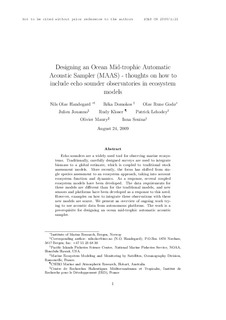| dc.contributor.author | Handegard, Nils Olav | |
| dc.contributor.author | Domokos, Réka | |
| dc.contributor.author | Godø, Olav Rune | |
| dc.contributor.author | Jouanno, Julien | |
| dc.contributor.author | Kloser, Rudy | |
| dc.contributor.author | Lehodey, Patrick | |
| dc.contributor.author | Maury, Olivier | |
| dc.contributor.author | Senina, Inna | |
| dc.date.accessioned | 2012-02-07T08:12:44Z | |
| dc.date.available | 2012-02-07T08:12:44Z | |
| dc.date.issued | 2009 | |
| dc.identifier.citation | This report is not to be quoted without prior consultation with the General Secretary. | no_NO |
| dc.identifier.uri | http://hdl.handle.net/11250/102954 | |
| dc.description.abstract | Echo sounders are a widely used tool for observing marine ecosystems.
Traditionally, carefully designed surveys are used to integrate
biomass to a global estimate, which is coupled to traditional stock
assessment models. More recently, the focus has shifted from single
species assessment to an ecosystem approach, taking into account
ecosystem function and dynamics. As a response, several coupled
ecosystem models have been developed. The data requirements for
these models are different than for the traditional models, and new
sensors and platforms have been developed as a response to this need.
However, examples on how to integrate these observations with these
new models are scarce. We present an overview of ongoing work trying
to use acoustic data from autonomous platforms. The work is a
pre-requisite for designing an ocean mid-trophic automatic acoustic
sampler. | no_NO |
| dc.language.iso | eng | no_NO |
| dc.publisher | ICES | no_NO |
| dc.relation.ispartofseries | ICES CM documents;2009/I:21 | |
| dc.subject | acoustics | no_NO |
| dc.subject | akustikk | no_NO |
| dc.subject | ecosystems | no_NO |
| dc.subject | økosystemer | no_NO |
| dc.title | Designing an Ocean Mid-trophic Automatic Acoustic Sampler (MAAS) - thoughts on how to include echo sounder observatories in ecosystem models | no_NO |
| dc.type | Working paper | no_NO |
| dc.subject.nsi | VDP::Agriculture and fishery disciplines: 900::Fisheries science: 920::Fisheries technology: 924 | no_NO |
| dc.source.pagenumber | 20 s. | no_NO |
